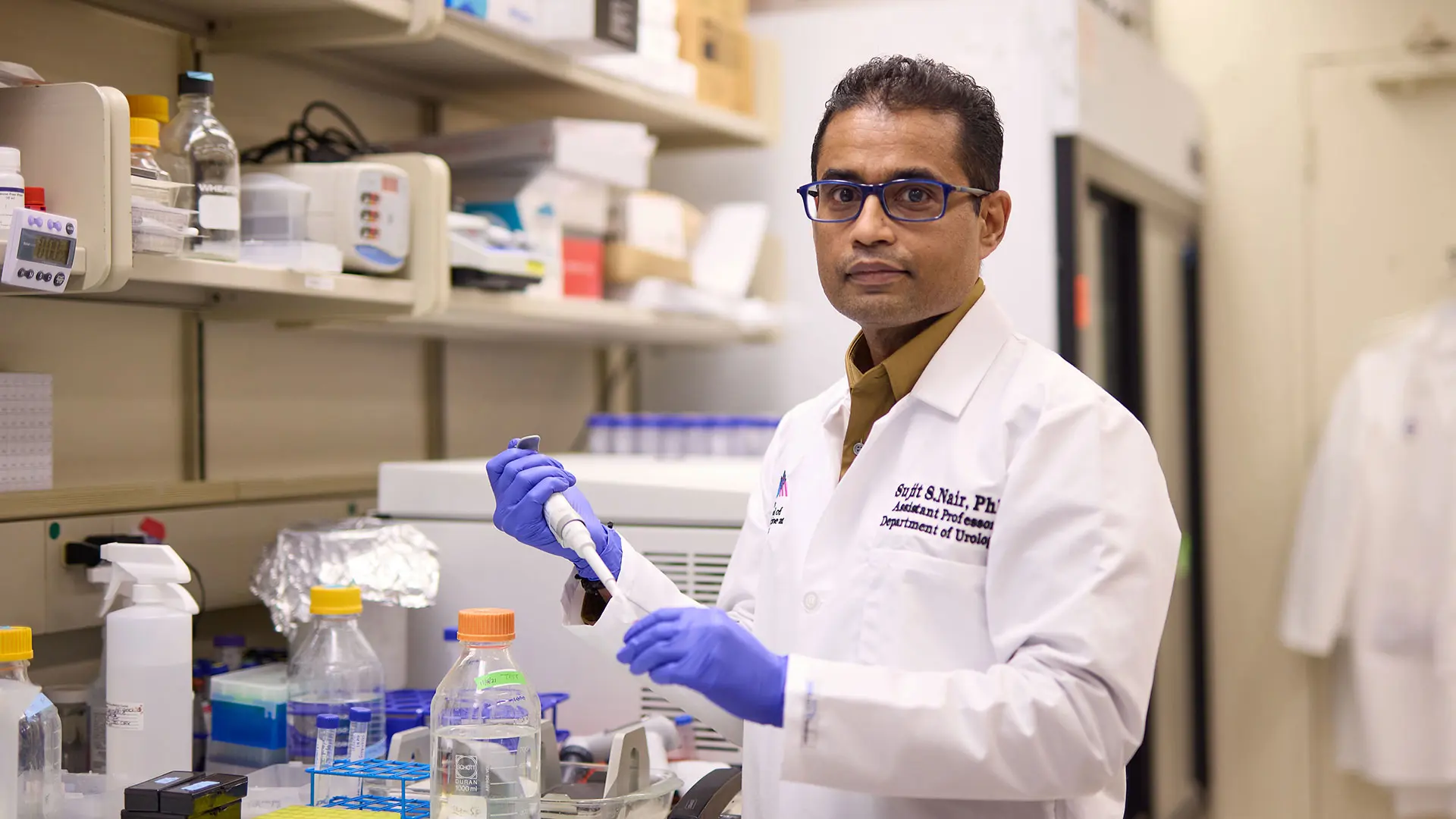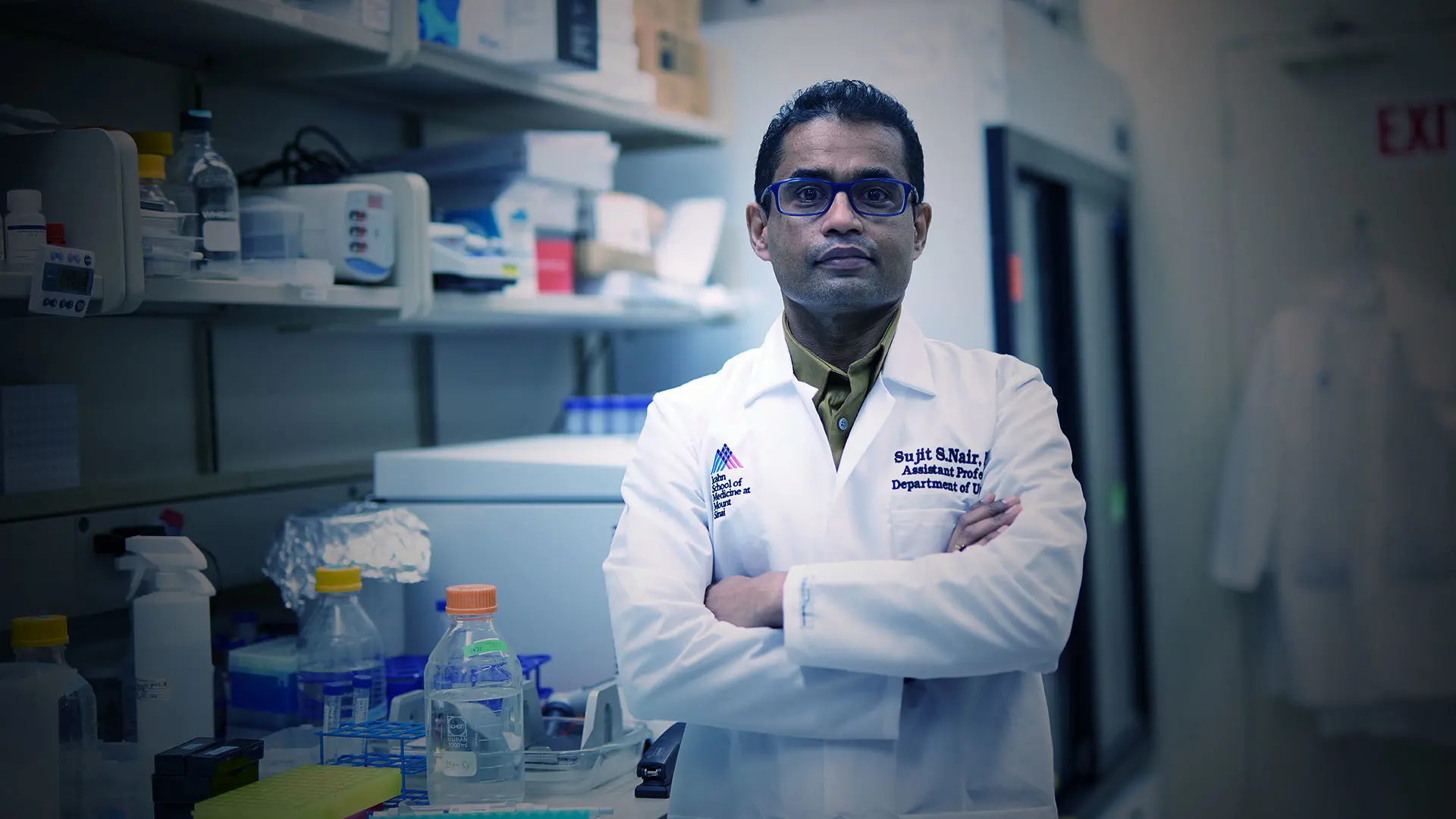Although there is considerable interest in using immunotherapy to combat and control prostate cancer, there has been little progress made in harnessing the potential of this approach. But two studies being conducted at Mount Sinai have the potential to result in major advances in this field of research.
In fall 2022, one of those studies reached a crucial point as two Mount Sinai patients with aggressive prostate cancer became the first to receive a potentially game-changing therapeutic treatment—personalized genome vaccines (PGV) in combination with CDX-301, a potent hematopoietic cytokine.
For Sujit S. Nair, PhD, it was the moment of truth in a phase one, open-label, single-center, proof-of-concept study of a therapeutic modality that has been explored through other cancer clinical trials.
Would the study, led by Ash Tewari, MBBS, MCh, FRCS (Hon.), Professor and System Chair, Milton and Carroll Petrie Department of Urology, and Director of the Center of Excellence for Prostate Cancer at The Tisch Cancer Institute at the Icahn School of Medicine at Mount Sinai, result in a treatment that is safe, tolerable, and effective? The answer is yet to be seen but Dr. Nair is confident about the prospects.

Sujit S. Nair, PhD, Assistant Professor and Director of Genitourinary (GU) Immunotherapy Research at the Department of Urology
“If we see a decrease in the systemic levels of prostate-specific antigens, that would be very encouraging,” says Dr. Nair, Assistant Professor and Director of Genitourinary (GU) Immunotherapy Research at the Department of Urology at Icahn Mount Sinai. “Given that we are vaccinating against the patient’s own antigens, we expect to see an optimal benefit.”
That, Dr. Nair says, will be the key for assessing the efficacy of immunotherapy as a method of treatment for patients with prostate cancer. The merits of the approach have been the subject of considerable debate, in part because a significant number of patients have not responded to immunotherapy modalities such as checkpoint inhibitors. This, Dr. Nair suggests, could be due to tumor-specific immunosuppressive mechanisms and incomplete restoration of adaptive immunity.
“The challenge is identifying the right antigen, because if we know which one is making the cancer worse, then we can vaccinate against that target,” he says. “That is what we are hoping to achieve in this study.”
In the second study, Drs. Nair and Tewari are assessing the efficacy and safety of intratumoral (IT) and intramuscular administration of poly-ICLC (polyinosinic-polycytidylic acid stabilized with polylysine and carboxymethylcellulose)—a stabilized double stranded RNA viral mimic—in a neoadjuvant setting among active surveillance patients. The single-blinded, randomized, placebo-controlled phase two study is unique in that it uses the patient’s own tumor as the antigen source. The study will also assess whether IT administration of poly-ICLC could induce an innate and adaptive anti-tumor immune response within the tumor and peripheral blood.
“IT immunotherapy is an emerging area that has not been tested in the clinical setting,” Dr. Nair explains. “Instead of a systemic vaccination, we are administering it into the tumor—essentially taking it to the battleground. To my knowledge, this is the first-ever study of IT vaccination involving any therapeutic agent.”
The study will recruit 114 participants who have a histologically confirmed adenocarcinoma of the prostate and who are categorized as International Society of Urological Pathology Gleason Group 1 and 2. Study subjects will be randomized and will receive a single IT injection of the study drug or placebo on weeks one and two followed by intramuscular injections (twice weekly) with a three-week rest period between intramuscular injections.
The primary objective is to determine the efficacy of the poly-ICLC vaccination in reducing the rate of Gleason group upgrade at three years on biopsy in prostate cancer subjects on active surveillance. The research team will also assess the biopsy at one year and the proportion of subjects with a downgrade on biopsy at that point. The secondary objectives involve evaluating the safety of poly-ICLC among individuals with low and intermediate risk localized prostate cancer and assessing the clinical benefit of the vaccine among individuals on active surveillance.
“Our hypothesis is that once we deliver the viral mimic to the tumor, it will generate an immune response that will result in cell killing,” Dr. Nair says. “That will generate a lot of dead cells, debris, and proteins that can be picked up by antigen-presenting cells and presented to the T cells. In that milieu of dead cells, there may be different antigens and that would generate a polyclonal response. Thus, we will not know against which antigen the response occurred, but we do know that we are providing an opportunity for many antigens to activate the immune cells.”
A phase one study involving IT and intramuscular administration of poly-ICLC among 12 patients—four cohorts of three—with high-risk clinically localized prostate cancer suggests this therapeutic approach could be impactful. Drs. Nair and Tewari observed that poly-ICLC was well tolerated, reaching a combined dose of 2.0 mg (two 1.0 mg/IT injections) in the fourth cohort. Pathological examination of post-surgical specimens resulted in downgrading of biopsy Gleason scores among 8 out of 12 patients. In 11 of 12 patients who received all therapies, the lymph nodes were negative.
The goal now, according to Dr. Nair, is to explore those findings further in a phase two study involving a larger cohort of high-risk patients in a neoadjuvant setting.
“This would be a window of opportunity study,” he says. “Essentially, we would be treating the tumor and exploring the result of that treatment after resection of the prostate to identify the changes that occurred. The result could be that we are able to reduce the tumor burden even before the prostate is surgically resected.”
